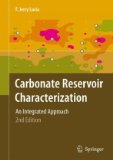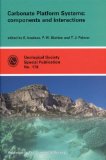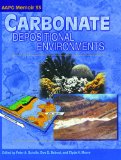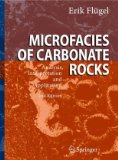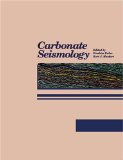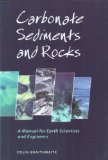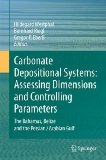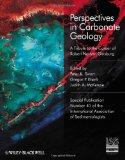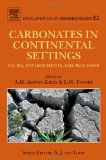
|
Carbonates in Continental Settings: Facies, Environments, and Processes
This book provides an up-to-date compilation of the latest research on the petrography, facies, paleonvironmental significance and economic aspects of continental carbonates. The overall organization of the book first emphasizes the descriptive aspects and processes operating on carbonate deposits in greatly varied settings, and then considers applications for basin analysis, as well as economic and historical aspects. This volume will be a valuable tool for graduate and postgraduate students as well as for experienced researchers. A CD that contains all colour figures has been inserted in the book. The second part (volume 62 in this series) will deal with the geochemistry, diagenesis and applications of carbonates in continental settings. |
|
Carbonate Reservoir Characterization: An Integrated Approach
F. Jerry Lucia, working in America’s main oil-rich state, has produced a work that goes after one of the holy grails of oil prospecting. One main target in petroleum recovery is the description of the three-dimensional distribution of petrophysical properties on the interwell scale in carbonate reservoirs. Doing so would improve performance predictions by means of fluid-flow computer simulations. Lucia’s book focuses on the improvement of geological, petrophysical, and geostatistical methods, describes the basic petrophysical properties, important geology parameters, and rock fabrics from cores, and discusses their spatial distribution. A closing chapter deals with reservoir models as an input into flow simulators. |
|
Carbonate Sedimentology
Carbonate rocks (limestones and dolomites) constitute a major part of the geological column and contain not only 60% of the world's known hydrocarbons but also host extensive mineral deposits. This book represents the first major review of carbonate sedimentology since the mid 1970's. It is aimed at the advanced undergraduate - postgraduate level and will also be of major interest to geologists working in the oil industry. This volume is designed to take the reader from the basic aspects of limestone recognition and classification through to an appreciation of the most recent developments such as large scale facies modelling and isotope geochemistry. Novel aspects of the book include a detailed review of carbonate mineralogy, non-marine carbonate depositional environments and an in-depth look at carbonate deposition and diagenesis through geologic time. In addition, the reviews of individual depositional systems stress a process-based approach rather than one centered on simple comparative sedimentology. The unique quality of this book is that it contains integrated reviews of carbonate sedimentology and diagenesis, within one volume. |
|
Carbonate Platform Systems: Components and Interactions
Carbonate Platform Systems: components and interactions is a collection of 13 papers, plus an introduction, concerning the effects of organism-environment interactions in modern and ancient carbonate platforms, arising from the Lyell Meeting on 'Organism-Environment Feedbacks in Carbonate Platforms and Reefs' held at the Geological Society, UK. The papers presented here provide an integrated view of carbonate platforms, emphasizing dynamic interactions at all hierarchical levels and revealing the limitations of uniformitarian analogy in biotically influenced sedimentary systems. Selected case studies from around the world illustrate aspects ranging from the genesis of growth fabrics to changing patterns of carbonate platform development. The text will be of interest to sedimentologists, palaeontologists and marine ecologists alike. |
|
Carbonate Depositional Environments
This is the book you need to improve your interpretations of carbonates. Using a systematic treatment of the entire subject of carbonate depositional environments, this unique book is specifically designed for use by the non-specialist -- the petroleum geologist or field geologist -- who uses carbonate depositional environments in facies reconstructions and environmental intepretations. This classic work, covering settings from non-marine to deep water, focuses on the recognition of depositional environments with extenive use of color diagrams and photographs of sedimentary structures and facies assemblages. Although the ultimate purpose of this text is to improve exploration for oil, gas, and mineral deposits, it also includes environments not normally considered to be particularly prospective for oil and gas in an attempt to provide as complete a framework as possible for recognition of environments. Suitable for use as a textbook, this book is also an invaluable reference fo the specialist or advanced graduate student. It provides perspective on large-scale influences on carbonate depositional envionments such as tectonic patterns, fluctuations of sea level, variations of climate, and evolutionary patterns of organisms. Companion to Memoir 31, this classic reference volume aids the specialist and nonspecialist in interpretation of carbonate depositional environments in facies reconstructions. Illustrated with hundreds of color diagrams and photographs of sedimentary structures and facies assemblages. |
|
Microfacies of Carbonate Rocks: Analysis, Interpretation and Application
This unparelleled reference synthesizes the methods used in microfacies analysis and details the potential of microfacies in evaluating depositional environments and diagenetic history, and, in particular, the application of microfacies data in the study of carbonate hydrocarbon reservoirs and the provenance of archaeological materials. Nearly 230 instructive plates (30 in color) showing thin-section photographs with detailed explanations form a central part of the content. Helpful teaching-learning aids include detailed captions for hundreds of microphotographs, boxed summaries of technical terms, many case studies, guidelines for the determination and evaluation of microfacies criteria, self-testing exercises for recognition and characterization skills, and more |
|
A Color Atlas of Carbonate Sediments and Rocks Under the Microscope
More than half of the world’s petroleum is found in carbonate rocks — for example, in the Middle East, the former USSR and in North America. These rocks show a bewildering diversity of grains and textures, due in part to the wealth of different fossil organisms that have contributed to carbonate sedimentation, and in part to a wide variety of diagenetic processes that can radically modify textures and obscure the depositional fabric. Careful petrographic study with a polarising microscope is a key element of any study of carbonate sediments — as a companion to field or core logging and as a necessary precursor to geochemical analysis. This atlas, which illustrates in full color a range of features not attempted in any general textbook, is designed as a laboratory manual to keep beside the microscope, and as an aid to identifying grain types and textures in carbonates. It will appeal alike to under-graduate and graduate students and to professionals in teaching institutions, research laboratories and industry. |
|
Carbonate Seismology
Although carbonates make up only 20% of the sedimentary rock record, they account for more than 50% of the world's proven oil reserves. Carbonates differ from siliclastics in generation, geomorphology, and diagenesis, all of which modify the mineralogy, porosity, and permeability so important to reservoir quality and 3-D seismic response. The first eight chapters establish the geologic framework and consist of state-of-the-art review papers written by recognized experts in carbonate generation, rock properties, sequence stratigraphy, seismic stratigraphy, and structural deformation. The last 10 chapters illustrate the seismic expression of carbonate terranes through carefully chosen case studies drawn from the United States, Venezuela, Norway, China, Saudi Arabia, Italy, and the Bahamas, augmented by two careful studies of seismic signal-to-noise problems specific to carbonates. A recurring theme in each of these case studies is the importance of integrating seismic and petrophysical control with geologic models to better predict carbonate facies quality and distribution. This book is destined to become a well-worn reference volume that sits easily within reach of every geologist, geophysicist, and engineer involved in the exploration or exploitation of carbonate reservoirs. |
|
Carbonate Sediments And Rocks: A Manual for Geologists And Engineers
Carbonate rocks are of fundamental importance in many respects: in the manufacture of cement, as building stone and aggregates, and they form the reservoirs for about 40% of the world's oil reserves. In engineering terms they frequently underly the most intractable geotechnical problems and often provide the foundations for coastal structures and offshore structures. This book provides the geological background to carbonate sediments and rocks and furnishes basic information on the compositions, origins, and distributions of carbonate sediments. The descriptions that follow provide models for the earth scientist and a predictive framework for engineering works in such areas. It provides a basic reference tool for the geologist and a reference framework in which the practising engineer unfamiliar with terms is able to understand and evaluate reports provided by experts from other fields. Case studies provide further elucidation. Readership: practitioners and students in earth science, engineering geology, petroleum geology, foundation and civil engineering. |
|
Carbonate Depositional Systems: Assessing Dimensions and Controlling Parameters: The Bahamas, Belize and the Persian/Arabian Gulf
Carbonate sediments are of increasing relevance for archives of past environmental conditions and for economical reasons in areas of geothermal energy and hydrocarbon reservoirs. Complex interaction of physical and chemical parameters with biological parameters determines the architecture and composition of carbonate sedimentary bodies. This book closes some of the still existing gaps in our understanding of the influence and interplay of physical, chemical, and biological parameters with carbonate sedimentation. An understanding of this interaction is not only required for reliable prediction of reservoir quality but also for a robust interpretation of environmental conditions in the past and the present. It is written by geologists for geologists in order to provide an easily accessible overview of the large amount of relevant information provided by the neighbouring sciences. The approach of the book is to document the modern depositional environments of three classical areas of carbonate deposition, each characteristic for a specific sedimentological setting (isolated platform, attached shelf, ramp) in order to assess both the range of physical, biological and chemical parameters and their sedimentary response. This book presents a comprehensive compilation based on data from published work and unpublished theses, and the integration of these data in order to extract previously undiscovered relationships between the discussed parameters and carbonate deposition. |
|
Perspectives in Carbonate Geology: A Tribute to the Career of Robert Nathan Ginsburg
This special publication Perspectives in Carbonate Geology is a collection of papers most of which were presented at a symposium to honor the 80th birthday of Bob Ginsburg at the meeting of Geological Society of America in Salt Lake City in 2005. The majority of the papers in this publication are connected with the study of modern carbonate sediments. Bob Ginsburg pioneered the concept of comparative sedimentology - that is using the modern to compare to and relate to and understand the ancient. These studies are concerned with Bob's areas of passion: coral reefs and sea-level; submarine cementation and formation of beach rock; surface sediments on Great Bahama Bank and other platforms; origin of ooids; coastal sediments; formation of stromatolites; impact of storms on sediments; and the formation of dolomite. The remainder of the papers apply the study of modern environments and sedimentary processes to ancient sediments. |
|
Mesozoic and Cenozoic Carbonate Systems of the Mediterranean and the Middle East: Stratigraphic and diagenetic reference models
This volume contains a collection of stratigraphic and diagenetic case studies of Mesozoic and Cenozoic carbonate sequences from the Tethyan realm. High levels of industry and academic interest in the region have generated numerous multi-disciplinary studies of these sequences, a selection of which are presented in this volume. The studies presented are based on both comprehensive subsurface datasets from important hydrocarbon-bearing strata of the Middle East and the excellent surface exposures in the region of interest. The studies presented in this volume may serve as suitable starting points in the development of age and architecture specific carbonate reference models. Such models can form the basis of internally consistent models for carbonate deposition, sequence development and reservoir performance. Ideally such models, suitably scaled, will be equally applicable to academic studies, the exploration and development phases of the field life cycle and in the prediction of future reservoir performance. |



































